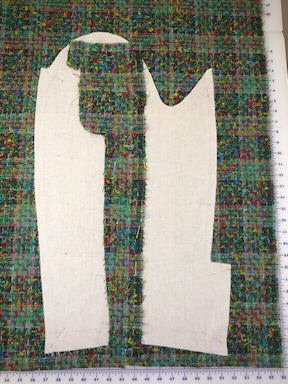
by Kathryn Brenne

Although it might not be visible upon first inspection, many novelty tweed and bouclé fabrics have a bit of a brushed or napped surface. I would recommend cutting all pattern pieces running in the same direction using a nap layout. Check fabric over for a repeating pattern, which may have to be matched. If the fabric is bulky or requires careful matching, it may be most accurate to cut out in a single layer. A rotary cutter can be useful for cutting bulky fabrics and also works well when cutting silk lining as it will provide nice smooth lines. Use a brand new blade to prevent snagging. Once the garment pieces have been cut, handle them carefully to minimize ravelling.
If your fabric has a definite repeat, a plaid or a stripe, it will require matching. Plan on purchasing extra fabric to allow for matching; allow at least a couple of extra design repeats so that you will be able to manipulate the pattern pieces. Before laying out the fabric, hold it up to yourself in front of a mirror to determine the most flattering placement of the design. Pay particular attention to the bust and hip areas. Determine where center front will be placed. Now you are ready to layout your pattern!
I begin by aligning center front. For most fabrics I mirror image the left and right sides of the garment. Work your way around the garment using the notches as reference points. Sometimes I will use coloured pencils to draw the pattern of the fabric onto the tissue paper at the notch. I can then match up the next piece by matching the notches and my coloured markings. Do not worry about the shoulder seams. If things go well you will end up with center back in a pleasing position. If center back does not match up as well as you had hoped, match the fronts, then match center back, then match the side seams horizontally and adjust the pattern vertically at the side seams if needed to compensate for center back. If you have to choose, it's more important that the center back be well-positioned than the sides. Once you are satisfied, cut out the body of the garment. Leave the sleeves to cut out after you have assembled the body of the garment.
Once the body of the garment is assembled, baste a muslin sleeve into the garment. To get the sleeve to match perfectly, I draw with a pencil the horizontal pattern from the garment onto the muslin sleeve.
I then take a good size scrap of fabric and pin it to the sleeve head, aligning the grain line with the grain line on the sleeve and matching the pattern of the scrap to the body of the garment.



If it looks good, I will place a predominant pattern down the center of the sleeve along the grain line. I then take out the muslin sleeve with the scrap still attached to it and use this as my pattern. I place it directly onto a single layer of fabric and match the pattern. Use a long ruler to help align the pattern.
Once I have cut the first sleeve, I turn it over wrong side facing up and use it as a pattern to perfectly match and cut the second sleeve. A well-matched garment should flow around the body seamlessly!

